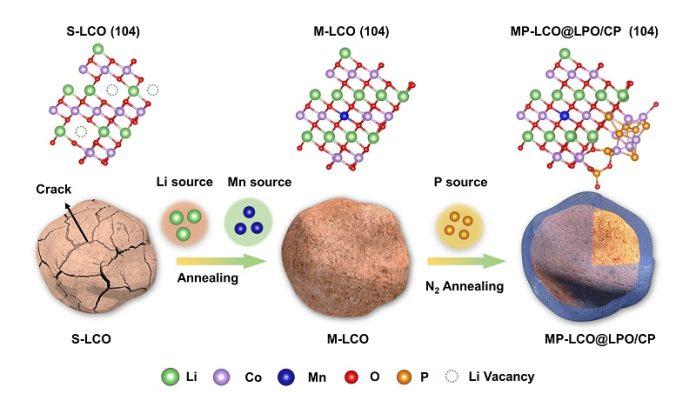
A team of researchers led by Prof. Zhang Yunxia from the Hefei Institutes of Physical Science, part of the Chinese Academy of Sciences, has developed a new way to improve old lithium cobalt oxide (LCO) batteries.
Their findings, published in the journal Advanced Materials, could help make these batteries more stable and efficient, especially at high voltages.
As the demand for high-energy storage devices increases, finding sustainable methods to upgrade old LCO batteries has become essential. The researchers have created a simple and effective method to achieve this.
Their approach combines wet chemical treatment, heating, and a special phosphorus coating technique.
Here’s how they did it:
- Extra Lithium Addition: They added extra lithium to the battery.
- Surface Coating: They applied a uniform coating of lithium phosphate/cobalt phosphide (LPO/CP) to the battery’s surface.
- Bulk Modification: They incorporated manganese into the bulk material and added a gradient of phosphorus near the surface.
These modifications were done all at once, resulting in a significantly improved battery performance.
The upgraded LCO cathode, named MP-LCO@LPO/CP, showed impressive improvements.
It now has a higher specific capacity, meaning it can store more energy, and it also has excellent cycling stability, which means it can be charged and discharged many times without losing performance.
The researchers wanted to understand why the upgraded cathode performs so well at high voltages. They discovered that the modifications enhanced both the structural stability and electrochemical properties of the battery, leading to better performance.
Prof. Zhang emphasized that this method is not only simple but also scalable, meaning it can be applied to recycle other waste cathode materials too.
“This approach has great potential for the sustainable development of the lithium-ion battery industry,” he said.
In summary, this new strategy could help breathe new life into old lithium batteries, making them more efficient and stable. This development is a significant step towards creating more sustainable energy storage solutions.



